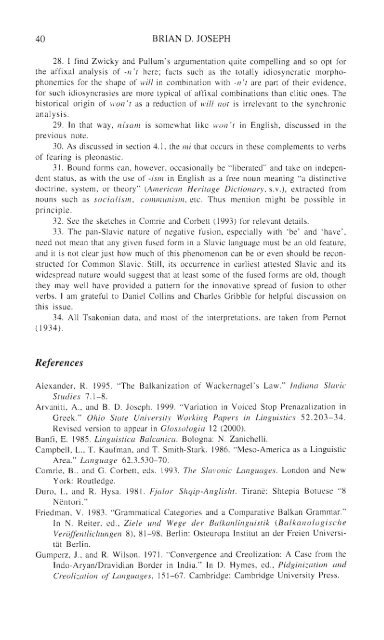Comparative Syntax of the Balkan Languages (Oxford ... - Cryptm.org
Comparative Syntax of the Balkan Languages (Oxford ... - Cryptm.org
Comparative Syntax of the Balkan Languages (Oxford ... - Cryptm.org
- No tags were found...
You also want an ePaper? Increase the reach of your titles
YUMPU automatically turns print PDFs into web optimized ePapers that Google loves.
40 BRIAN D. JOSEPH28. I find Zwicky and Pullum's argumentation quite compelling and so opt for<strong>the</strong> affixal analysis <strong>of</strong> -n't; here; facts such as <strong>the</strong> totally idiosyncratic morphophonemicsfor <strong>the</strong> shape <strong>of</strong> will in combination with -n't are part <strong>of</strong> <strong>the</strong>ir evidence,for such idiosyncrasies are more typical <strong>of</strong> affixal combinations than clitic ones. Thehistorical origin <strong>of</strong> won't as a reduction <strong>of</strong> will not is irrelevant to <strong>the</strong> synchronicanalysis.29. In that way, nisam is somewhat like won 't in English, discussed in <strong>the</strong>previous note.30. As discussed in section 4.1, <strong>the</strong> mi that occurs in <strong>the</strong>se complements to verbs<strong>of</strong> fearing is pleonastic.31. Bound forms can, however, occasionally be "liberated" and take on independentstatus, as with <strong>the</strong> use <strong>of</strong> -ism in English as a free noun meaning "a distinctivedoctrine, system, or <strong>the</strong>ory" (American Heritage Dictionary, s.v.), extracted fromnouns such as socialism, communism, etc. Thus mention might be possible inprinciple.32. See <strong>the</strong> sketches in Comrie and Corbett (1993) for relevant details.33. The pan-Slavic nature <strong>of</strong> negative fusion, especially with 'be' and 'have',need not mean that any given fused form in a Slavic language must be an old feature,and it is not clear just how much <strong>of</strong> this phenomenon can be or even should be reconstructedfor Common Slavic. Still, its occurrence in earliest attested Slavic and itswidespread nature would suggest that at least some <strong>of</strong> <strong>the</strong> fused forms are old, though<strong>the</strong>y may well have provided a pattern for <strong>the</strong> innovative spread <strong>of</strong> fusion to o<strong>the</strong>rverbs. I am grateful to Daniel Collins and Charles Gribble for helpful discussion onthis issue.34. All Tsakonian data, and most <strong>of</strong> <strong>the</strong> interpretations, are taken from Pernot(1934).ReferencesAlexander. R. 1995. "The <strong>Balkan</strong>ization <strong>of</strong> Wackernagel's Law." Indiana Slavic-Studies 7.1-8.Arvaniti, A., and B. D. Joseph. 1999. "Variation in Voiced Stop Prenazalization inGreek." Ohio State University Working Papers in Linguistics 52.203-34.Revised version to appear in Glossologia 12 (2000).Banfi, E. 1985. Linguistica Balcanica. Bologna: N. Zanichelli.Campbell, L., T. Kaufman, and T. Smith-Stark. 1986. "Meso-America as a Linguistic-Area." Language 62.3.530-70.Comrie, B.. and G. Corbett, eds. 1993. The Slavonic <strong>Languages</strong>. London and NewYork: Routledge.Duro, I., and R. Hysa. 1981. Fjalor Shqip-Anglisht. Tirane: Shtepia Botuese "8Nentori."Friedman, V. 1983. "Grammatical Categories and a <strong>Comparative</strong> <strong>Balkan</strong> Grammar."In N. Reiter, ed., Ziele und Wege der <strong>Balkan</strong>linguistik (<strong>Balkan</strong>ologischeVer<strong>of</strong>fentlichungen 8), 81-98. Berlin: Osteuropa Institut an der Freien Universita'tBerlin.Gumperz, J., and R. Wilson. 1971. "Convergence and Creolization: A Case from <strong>the</strong>Indo-Aryan/Dravidian Border in India." In D. Hymes, ed., Pidginization andCreolization <strong>of</strong> <strong>Languages</strong>, 151-67. Cambridge: Cambridge University Press.
















